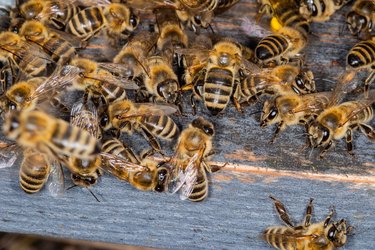
Is there a buzzing in your walls or unwanted flying guests inside your home? Seeing a few bees flying around your garden is common, especially if you have a garden that attracts bees, but seeing swarms of bees or finding several inside your home could indicate that the bees have decided to move in. The best way to remove bees from your home is to leave it to a professional. Bees are important pollinators, so relocating them without harming them is ideal.
Why Bees Enter Homes
Video of the Day
Large bee colonies occasionally break off with about half of the bees finding a new place to live, usually in the spring. The scout bees set out to look for a large, dark cavity with an entrance that's easy to protect. That's often in a tree, under a deck, or along a fence, but bees sometimes choose the walls of a building as their new home.
Video of the Day
Bees can get into homes through very small holes, as little as a quarter of an inch. Examples of entry points include:
- Chimneys.
- Exterior vents.
- Holes caused by gutters.
- Gaps or cracks in exterior walls.
- Pipes.
Challenges of Bees in Homes
Relocating a swarm outside your home is relatively easy because they're accessible to a beekeeper. Bees that build a nest inside your walls are much more difficult to reach. They can fit through tiny holes, but a beekeeper or exterminator needs a much larger hole to get them out. They also leave behind a sticky mess that needs to be cleaned up.
Damage Bees Cause
Honeybees sometimes soften the drywall with water for more nesting space. They can also create a hole in the drywall, which might result in bees entering your living area. Honey produced by honeybees in your wall can ferment or leak inside the walls after the bees are gone. It can damage the walls and ceilings.
Killing bees inside the wall can cause them to pile up, retain body moisture, and rot, which creates odors in your home and can cause damage to the home's structure. The pesticides used can also add to the complexity, creating hazardous waste when combined with the bees and leftover honey.
Getting Rid of Bees
Bee removal should always be handled by a professional, either a beekeeper or a pest control professional who has extensive bee removal experience. Choosing a professional who tries to relocate the bees instead of killing them is ideal. Professionals have the right protective gear and equipment to remove the bees safely.
The bee removal company will locate the bee nest inside the walls, usually by tapping on your walls until they hear the buzzing or using a stethoscope. Removing the nest requires the bee removal specialist to cut a hole in the wall. They have various methods of collecting the bees and removing the combs. If any trace of beeswax or combs remains, it will attract more bees to your home.
You might need to hire a separate contractor to fix the damage caused by the bees. Most beekeepers and pest control companies only handle the removal process. A contractor can finish the repair work seamlessly to restore your home.
Preventing Future Infestations
After you evict the bees, seal up any potential entry points for future swarms. Blocking or patching the holes and openings decreases the chances of the scout bees finding a way into your home. Filling the cavities in your walls with insulation after all bee remnants are removed can also help discourage future bee infestations. Be careful with sheds, grills, and other things near your home that have a large cavity that bees might like.
Choose landscaping that discourages bees. Some flowering plants don't attract bees, so you can still have a colorful garden without drawing in more bees. You can also keep bees out of your house by placing flowers away from your home, keeping them in other areas of your yard.